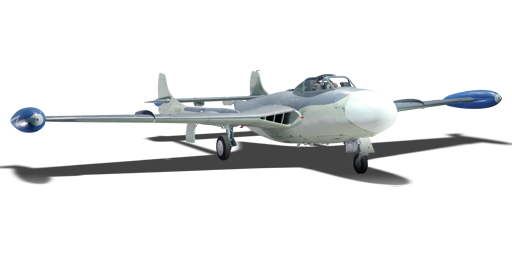



Following the development of the de Havilland Venom for the RAF, the Royal Navy also expressed an interest in acquiring the aircraft for its Fleet Air Arm. The twin-seat night-fighter variant NF.2 was modified to be suitable for aircraft carriers, featuring a strengthened undercarriage, folding wings, and tailhook. This first navalised variant was designated the Sea Venom FAW.20, operating as naval interceptors from 1951. It eventually began to be replaced by the de Havilland Sea Vixen in 1959, with the final units withdrawn from second-line service in 1970.
Introduced in Update 1.57 "Battle March", the Sea Venom is a shadow of its land-based sibling, with remnants of its power and manoeuvrability marred by the significant increase in weight from the naval modifications. However, with its relatively advanced airframe and nonetheless powerful engine, the lower BR causes the Sea Venom to be one of the fastest aircraft at the BR. Unlike the Venom, turnfighting should be avoided, as the Sea Venom will lose significant amounts of energy while doing so and will soon end up floating in the air. Instead, use its speed to make fast passes against unsuspecting opponents, and quickly zoom away from danger before they can even think about giving chase.
flaps
flaps
flaps
brake
| Belt | Belt filling | Armor penetration (mm) at a distance: | |||||
|---|---|---|---|---|---|---|---|
| 10 m | 100 m | 500 m | 1000 m | 1500 m | 2000 m | ||
| HEI/SAP-I/T | 21 | 19 | 14 | 9 | 5 | 4 | |
| AP-T/HEI/SAP-I | 36 | 33 | 24 | 15 | 10 | 7 | |
| SAP-I/HEI/AP-T/HEI/SAP-I | 36 | 33 | 24 | 15 | 10 | 7 | |
| AP-T/HEI/T | 36 | 33 | 24 | 15 | 10 | 7 | |
| AP-T/SAP-I/HEI/AP-T | 36 | 33 | 24 | 15 | 10 | 7 | |
| HEI/SAP-I | 22 | 20 | 14 | 9 | 6 | 4 | |












Flight performance | |
|---|---|
Survivability |
|---|
Weaponry |
|---|